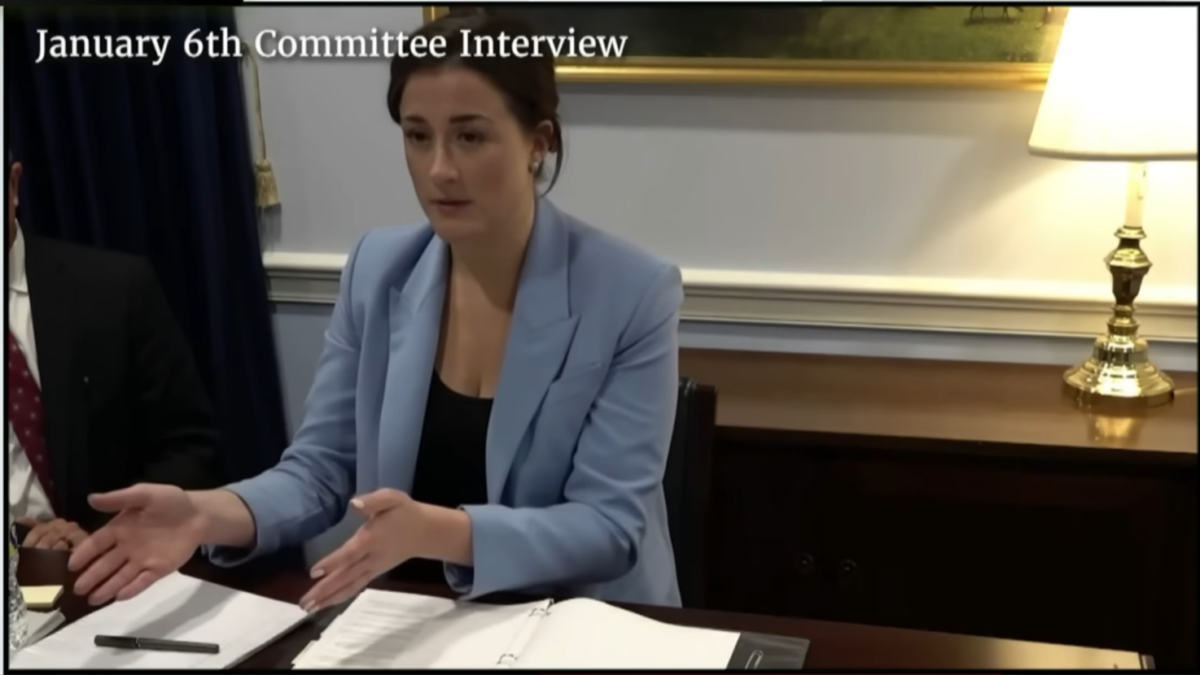In case you needed further proof that the Soviet-style show trial being conducted by Rep. Liz Cheney and the rest of Nancy Pelosi’s Jan. 6 Committee is a sham that would never hold water in a court of law, look to the committee’s most recent use of rampant hearsay in last week’s testimony from Cassidy Hutchinson.
The now-unemployed Hutchinson was an assistant to former White House Chief of Staff Mark Meadows. She testified that White House Deputy Chief of Staff Tony Ornato relayed to her a story that as President Trump was returning to the White House after the rally on the Ellipse, he angrily lunged forward from the back seat of the Beast (the presidential armored limousine which Trump was not using that day) and grabbed the steering wheel, presumably to steer the car back towards the Capitol. According to Hutchinson, the president then assaulted the chief of his own Secret Service detail, Bobby Engel, who had tried to restrain him.
It has been reported that Ornato has denied telling Hutchinson what she claims he said. Both NBC and CBS have reported that Engel and the SUV driver were prepared to testify under oath that the events described by Hutchinson never happened. These and other problems with Hutchinson’s testimony have been well-documented by now, but the most egregious aspect is that her hearsay testimony never should have been publicly aired and promoted as true by Cheney and the committee.
Hutchinson had no first-hand knowledge about what happened in the vehicle. Her testimony about the events in the vehicle was unreliable hearsay, untested and unverified by the slightest pretense of any cross-examination. In fact, it was double hearsay because Hutchinson claims that she heard it from Ornato, who supposedly heard it from someone else, presumably Engel. Such rank hearsay never would be admitted in a judicial proceeding precisely because of its lack of reliability.
Think of the rule against hearsay as basically excluding gossip, i.e., when one person merely repeats what someone else told them, in an effort to prove the truth of whatever the first person said. Cheney and the committee clearly were attempting to publicize the allegations about a fracas in the Beast to give the entire country the impression the statements were true, that those things happened, and that they depict an unhinged, out-of-control president. Unless one of the enumerated exceptions to the hearsay rule applies (and no one that I have seen has made a serious argument that they do), the statements may not be considered for their alleged truth.
No Cross-Examination of Eyewitnesses
The absence of the opportunity for cross-examination of those with first-hand knowledge of the events in question – Ornato, Engel, and the thus-far unidentified SUV driver – probably is the most important reason for excluding hearsay testimony, such as that offered by Hutchinson. The right to cross-examination is a bedrock principle of fairness in the American legal system.
Cheney was the only person who questioned Hutchinson. She did not even pretend to pose any probing questions that would have tested Hutchinson’s veracity. Nor did she disclose that they had already deposed both Ornato and Engel or what those witnesses with first-hand knowledge of the events had said.
Not only did Cheney and the committee publicly rely on hearsay testimony in their continuing show trial, they compounded the illegitimacy of the proceedings by failing to call the agents who do have first-hand knowledge of what was said, and who apparently dispute Hutchinson’s account. That failure destroys any remaining shred of credibility that she and the committee might have.
J6 Committee Is More Show Trial than Investigation
Some commentators, such as Andrew McCarthy writing at the ersatz conservative National Review, argue that it does not matter that the statements were hearsay because the committee is not bound by the federal rules of evidence. They argue that the committee is merely conducting an “investigation,” and investigators frequently rely upon hearsay testimony to develop leads. Of course the rules of evidence do not control congressional hearings. If the committee wanted to have disputes settled by flipping a coin or trial by combat, one supposes they could do that. But it would be regarded (at least by most) as unfair and contrary to traditional norms that Americans follow in settling disputes and seeking the truth.
This phony “investigation,” however, was conducted on live TV and choreographed by a former TV producer. It was promoted with great fanfare with the express intention of publicizing Hutchinson’s unreliable testimony as the gospel truth, in order to smear President Trump, cast doubt on his stability, and intimidate others who might be tempted to defend him.
This was a show trial, not an investigation. By ignoring any testimony from the agents present in the SUV and instead promoting this “bombshell” hearsay for illegitimate ends, Cheney and the other members of her committee have flouted fundamental norms of fairness and truth-seeking. In doing so, they have blown up what little might have remained of their credibility.
 https://thefederalist.com/wp-content/uploads/2022/07/image-2022-07-06T140257.381-e1657130631352-300x168.png 300w" sizes="(max-width: 1200px) 100vw, 1200px" />
https://thefederalist.com/wp-content/uploads/2022/07/image-2022-07-06T140257.381-e1657130631352-300x168.png 300w" sizes="(max-width: 1200px) 100vw, 1200px" />
You need to be a member of 12160 Social Network to add comments!
Join 12160 Social Network